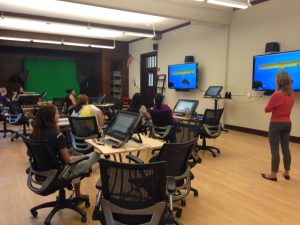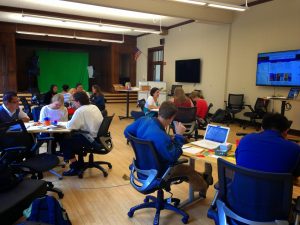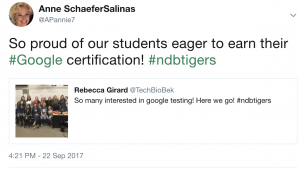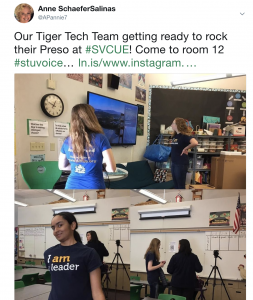If there is one thing I have learned, it is that every school is different. We each foster learning communities that meet the needs of our students, parents, and teachers. We are doing our very best to prepare our students to be leaders with integrity in the world that they will inherit. One important aspect of that world is the responsible use of technology.
Seven years ago, technology was something of an annoyance. Our faculty all had laptops. However, there really wasn’t a very organized process for determining what we were going to actually DO with technology and it certainly wasn’t pushing into the classrooms. This was the same time that iPads were hitting the scene. Decisions had to be made about what direction we were going to take–mobile devices or more traditional laptops. We opted for requiring students to bring their own laptops and we have invested in multiple iPad carts that any teacher can use for their lessons.
At the same time as the explosion of mobile technology and its push into schools, one of our teachers was earning a master’s in Education Media Design and Technology. As she and I began attending conferences and hearing the stories of other school journeys to integrate technology, incorporate student voice and choice, and empower teachers to create dynamic lessons, we realized that we wanted the same for our school. But we also knew that the two of us couldn’t do it alone. We started with a committee of interested faculty and staff, but quickly shifted to a blended committee that included students. Three years ago we made another change and now Rebecca Girard, our Ed Tech Coordinator (who prefers the title “Ed Tech Instigator”) leads a team that is all students. We currently have four Board Members, but have had as many as six. These students have contributed to an impressive list of accomplishments that include:
- The creation of our Innovation Lab and teacher training on topics such as Design Thinking, PBL, and Google tools
- The development and design of our student AUP (called our +1 Policy)
- The board allocated funds to upgrade technology in all classrooms
- All board members have earned their Google certification two years in a row
- The creation of a podcast, Towards the Sun (available on SoundCloud)
- Presentations at a local annual tech conference, Teach Through Technology–also known as T3–sponsored by the Silicon Valley CUE chapter
- Presented a poster session at the 2017 California STEAM Symposium
These girls are energetic and proud of the fact that they are contributing to an important aspect of their high school education.
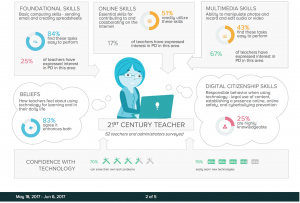 Several years ago we “upped the ante” again by engaging BrightBytes as a partner in technology planning. Working with BrightBytes has been another game changer for our school. If you aren’t familiar with the work that BrightBytes does, in a nutshell, the school collects data twice a year that reflects our progress (or lack of) according to their CASE framework (Classroom, Access, Skills and Environment). The information that we have gathered from these surveys (administered to students, faculty, staff, and now parents) has been invaluable in helping us identify topics on which we should focus our Professional Learning, where we need to spend money (hardware, software, infrastructure), and what big projects to focus on next. What has been particularly rewarding for me is to watch the students dive into the data along with us. Here is some of the data that we gathered last spring. As a result, Digital Citizenship and education for the faculty around the 4C’s are some of the areas we are building on this year. The Common Core standards emphasize the importance of real world applications and authentic audience. It doesn’t get more real or authentic than dealing with actual data and devising next steps for your school based on that information.
Several years ago we “upped the ante” again by engaging BrightBytes as a partner in technology planning. Working with BrightBytes has been another game changer for our school. If you aren’t familiar with the work that BrightBytes does, in a nutshell, the school collects data twice a year that reflects our progress (or lack of) according to their CASE framework (Classroom, Access, Skills and Environment). The information that we have gathered from these surveys (administered to students, faculty, staff, and now parents) has been invaluable in helping us identify topics on which we should focus our Professional Learning, where we need to spend money (hardware, software, infrastructure), and what big projects to focus on next. What has been particularly rewarding for me is to watch the students dive into the data along with us. Here is some of the data that we gathered last spring. As a result, Digital Citizenship and education for the faculty around the 4C’s are some of the areas we are building on this year. The Common Core standards emphasize the importance of real world applications and authentic audience. It doesn’t get more real or authentic than dealing with actual data and devising next steps for your school based on that information.
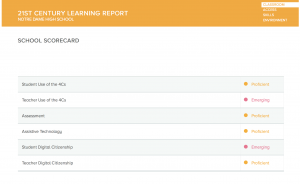 I hope that you are feeling inspired rather than overwhelmed or defeated as you read about our school’s journey. Remember, this has been evolving for seven years. I think that sometimes we get so focused on wanting to make things happen “right now.” But “right now” isn’t always what’s best. Yes, technology is important, but it isn’t the only component of the education that we are providing our students. If I was to boil all of this down into actionable steps for other schools, I would say:
I hope that you are feeling inspired rather than overwhelmed or defeated as you read about our school’s journey. Remember, this has been evolving for seven years. I think that sometimes we get so focused on wanting to make things happen “right now.” But “right now” isn’t always what’s best. Yes, technology is important, but it isn’t the only component of the education that we are providing our students. If I was to boil all of this down into actionable steps for other schools, I would say:
- Find a “partner in crime” to brainstorm with and be your cheerleader (of course, you need to be their cheerleader too!)
- Involve some students because they are directly affected by your technology decisions
- Start small, with the intention of adding something each year
- Celebrate your victories
- Don’t worry about getting the entire faculty on-board. Rather, target a few “early adopters” and then hire with an eye to technology use and innovative thinking
- Be patient
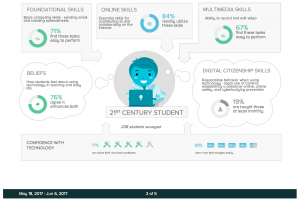 Technology isn’t going anywhere and our students need to be able to utilize technology in clear, adept, and innovative ways as they prepare to step into the world ahead. We need to do all that we can to be sure we are providing opportunities on our campuses for them to grow as students, contributors and leaders. Technology has become a great avenue for us to incorporate student voice and has allowed us as adults to really see them take ownership and provide valuable input. I hope that you are inspired to try something new on your campus!
Technology isn’t going anywhere and our students need to be able to utilize technology in clear, adept, and innovative ways as they prepare to step into the world ahead. We need to do all that we can to be sure we are providing opportunities on our campuses for them to grow as students, contributors and leaders. Technology has become a great avenue for us to incorporate student voice and has allowed us as adults to really see them take ownership and provide valuable input. I hope that you are inspired to try something new on your campus!
Anne Schaefer-Salinas is currently the Associate Head of School for Academics at Notre Dame High School, Belmont CA. She can be reached at @APAnnie7 and aschaefer@ndhsb.org.
